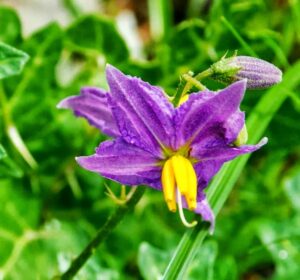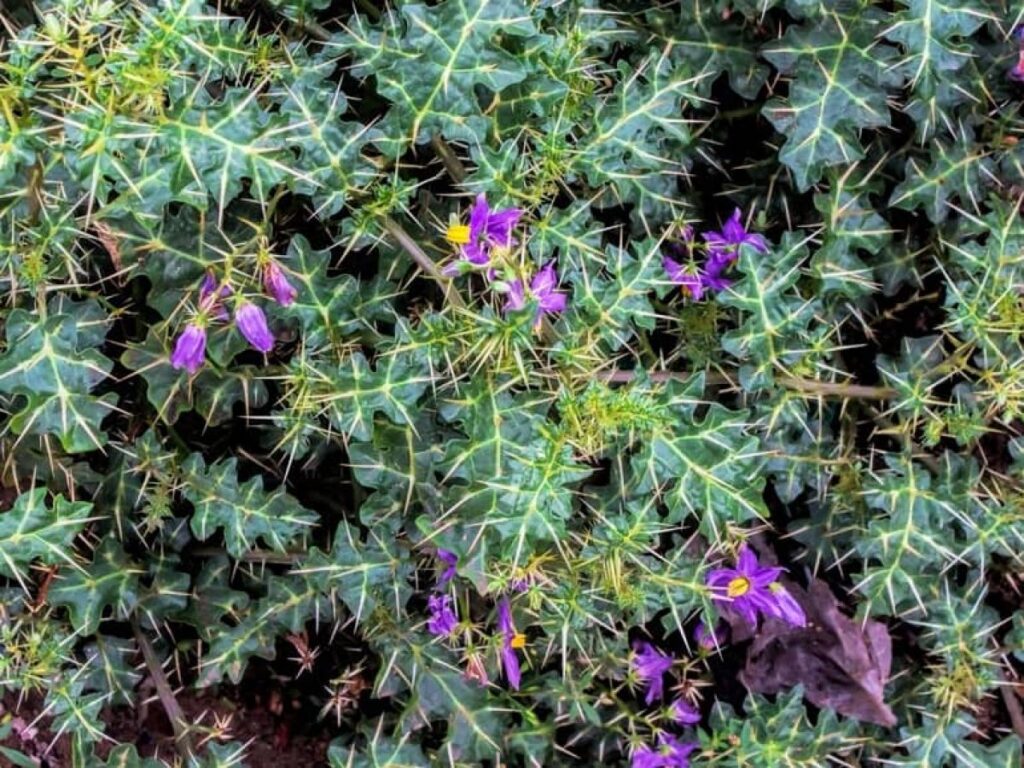Herb
Kantakari (Solanum xanthocarpum) Herb Ayurvedic Overview
Kantakari (Solanum xanthocarpum) comprises of mature, dried whole plant of Solanum surattense. It is a perennial, very thorny diffused herb of wasteland, found all over India.
Kantakari is widely used in managing various types of Jwara, Kasa, Hikka, and Tamaka Swasa. A lot of Ayurvedic formulations consist of Kantakari as one of the key ingredients. The plant is known for various pharmacological activities like antibacterial, antifungal, anti-asthmatic, anthelmintic, and hypoglycaemic properties.
Table of Contents
Scientific Classification of Kantakari (Solanum xanthocarpum):
- Kingdom: Plantae
- Subkingdom: Tracheobionta
- Division: Magnoliophyta
- Class: Magnoliopsida
- Subclass: Asteridae
- Order: Solanales
- Family: Solanaceae
- Genus: Solanum
- Species: xanthocarpum/ surattense
Kantakari (Solanum xanthocarpum) Synonyms:
- Sanskrit: Vyaghri, Nidigdhika, Ksudra, Kantakarika, Dhavani, Nidigdha, Dusparsa
- Assamese: Katvaedana, Kantakar
- Bengali: Kantakari
- English: Febrifuge plant
- Gujrati: Bharingani
- Hindi: Katai, Katali, Ringani, Bhatakataiya, Chhotikateri
- Kannada: Nelagulla, Kiragulla
- Kashmiri: Kath
- Malayalam: Kantakari chunda
- Marathi: Bhauringani, Kataringani
- Oriya: Bhejibaugana, Ankarati, ChakadaBhoji
- Punjabi: Kandiari
- Tamil: Kandangatri, Kandankatri, Kandanghathiri
- Telugu: Nelamulaka, Pinnamulaka, Mulaka, Chinnamulaka, Vakudu
Kantakari (Solanum xanthocarpum) Description:
 a) Macroscopic: Root: The root is 10 to 45 cm long, few mm to 2 cm in diameter, almost cylindrical and tapering, bearing several fine longitudinal and few transverse wrinkles with intermittent scars and wide compact cylinder of wood, fracture, short, taste, bitter.
a) Macroscopic: Root: The root is 10 to 45 cm long, few mm to 2 cm in diameter, almost cylindrical and tapering, bearing several fine longitudinal and few transverse wrinkles with intermittent scars and wide compact cylinder of wood, fracture, short, taste, bitter.
Stem: Stem is herbaceous, prickly with prominent nodes and internodes, green when is fresh, young branches, covered with innumerable hairs, mature ones glabrous, furrows better known in young stem appearing almost circular towards the basal region, stem pieces 8 to 10 mm thick of variable length.
The external surface is light green, when dry, the surface is yellowish-green and smooth, transversely smoothened surface shows a fragile bark and prominent wood, the center represents a significant and distinct, pith, mature and dry stem frequently with a hollow core, fracture short to slightly fibrous.
Leaves: The leaves are petiolate, exstipulate, ovate-oblong or elliptic, sinuate or sub-pinnatifid, subacute hairy, 4 to 12.5 cm long, and 2 to 7.5 cm wide, green, veins and midrib complete with sharp prickles, odor, and taste are not distinct.
Flower: Flower is ebracteate, pedicellate, bisexual, pentamerous, complete, regular, bright blue or bluish-purple, calyx-persistent, gamosepalous. The tube is short, globose, linear-lanceolate, acute, and hairy. It is 0.5-1 .3 cm long and densely prickly, corollagamopetalous, lobes deltoid, acute, hairy, 1-2 cm long and purple, stamens 5, basifixed, epipetalous, filament short 1-1.5 mm long, anther, oblong-lanceolate, 0.7 to 0.8 cm long, ovary superior, glabrous, oblong, bilocular with axile placentation having numerous ovules.
Fruit: The fruit is berry globular, measuring about 0.8 to 1 cm in diameter, and is surrounded by persistent calyx at the base. The unripe fruits variegated with white and green strips, ripe fruit shows different white and yellow shades.
Seeds: Seeds of kantakari are circular, numerous, flat, embedded in a mesocarp about 0.2 cm in diameter. The glabrous taste is bitter and acrid.
b) Microscopic: Root: The transverse section of mature root manifest cork composing of 3 to 6 layers of thin-walled, rectangular, and tangentially elongated cells, cork cambium single-layered accompanied by 6 to 15 layers of thin-walled, tangentially extended to oval or circular parenchymatous cells, stone cells are either single or groups of 2 to 20 or even more present in this region, secondary phloem consists of sieve elements and phloem parenchyma crossed by medullary rays, stone cells present in singles or groups of 2 to 20 in outer, and middle phloem regions, phloem rays 1 to 4 cells wide and 2 to 22 cells high.
The cambium 3 to 5 layered of thin-walled rectangular cells, xylem composed of vessels, tracheids, fiber tracheids, parenchyma and transversed by the medullary rays, all elements being lignified, tracheids and vessels with bordered pits, fibers with hardly any simple pits, xylem parenchyma rectangular or lightly elongated with simple pits and hardly with reticulate thickening, xylem rays 1 to 3 cells wide and 1 to 20 cells high, micro sphenoidal crystals of calcium oxalate as sandy masses and simple starch grains existing in the secondary cortex, phloem, and medullary rays.
Stem: The transverse section of mature stem, 1.5 to 2 cm thick consists of 6 to 12 layers of cork of thin-walled somewhat rectangular cells, epidermis remains complete for a long time. The secondary cortex consists of 7 to 11 layers of parenchymatous cells. Some cells are thickened and lignified establishing stone cells. The primary cortex remains intact even in quite a mature stage but later on, it gets crushed.
The pericyclic fiber, occur singly or in small groups of 2 to 3, secondary phloem comprises of sieve elements, parenchyma, a few threads, stone cells and traversed by phloem rays, fibers found distributed in singles or small groups in outer and middle phloem region, inner phloem devoid of fibers, stone cells consist in singles or small groups of 2 to 4, phloem rays, 1 to 2 or rarely 3 cells wide, cambium composed of 2 to 3 layers.
The xylem comprises parenchyma, fibers, vessels, tracheids, and traversed by xylem rays. The vessels vary broadly in size and shape and show bordered pits. Tracheids are elongated with irregular walls and bordered pits, fibers are much elongated, thick-walled, and lignified with tapering and pointed ends, some having truncated lots or bifurcated at one or both ends with a few simple pits, tracheids fibers compact than fibers, with both ends tapering and having reticulate thickening, xylem parenchyma cubical to rectangular with simple or bordered pits or the reticulate thickening, xylem rays conspicuous by their pitted thickenings, longer in size and radial elongation of cells, 1 to 2 or rarely 3 cells wide and 2 to 25 cells high.
The internal phloem consists of sieve elements and parenchyma, forming a more or less continuous band and embedded in per medullary zone, a few phloem fibers similar to those of outer phloem region are also present, a central region occupied by a large pith, micro sphenoidal crystals of calcium oxalate as sandy masses and simple starch grains present in the cortex, secondary cortex, phloem, medullary rays, and the pith cells.
Leaves: Petiole: transverse section of petiole represents circular to wavy outlines, epidermis single-layered, covered externally by thick cuticle, hypodermis consists of 3 to 4 layers of collenchymatous, cells, one large-crescent-shaped, central vascular bundle, collateral, and two small lateral bundles are present, rest of tissue of petiole is composed of polygonal, angular, thin-walled, parenchymatous cells, epidermis shows mostly stellate and very rarely, turn to tricellular hairs.
Midrib: transverse section of midrib represents a biconvex structure, epidermis on either side covered externally by thick cuticle, below epidermis 3 to 4 layers of collenchyma present, stele composed of crescent-shaped, bi collateral, central vascular bundle, and two small lateral vascular bundles, rest of tissue composed of thin-walled, parenchyma, some stellate hair are present on epidermis.
Lamina: transverse section represents dorsiventral structure, epidermis on either side, wavy in outline, covered externally by thick cuticle, on upper side mesophyll consist of a single-layered palisade and 4 to 6 layers of loosely arranged spongy parenchyma, some stellate hairs (4 to 8 armed) present on both sides of the epidermis, anisocytosis stomata present on both surfaces, vein-islet number 46 to 80 on the lower epidermis (mean 63), 61 to 80 on the upper epidermis (mean 70), stomatal index 20 to 25 (mean 22.5) on the lower epidermis, 14 to 24 (mean 19) on the upper epidermis, palisade ratio 1.7 to 4 (mean 2 .85).
Fruit: transverse section of mature fruit represents single-layered epidermis, covered externally by a thin cuticle, 1 to 2 layers of collenchyma present below the epidermis, mesocarp consist of thin-walled, oval to polygonal cells, some fiber., vascular bundles consist of scattered seeds composed of thick-walled radially elongated testa, little endosperm with the embryo, and few endosperm cells containing oil globules.
Identity, Purity, and Strength of Kantakari (Solanum xanthocarpum):
- Foreign matter Not more than 2 percent, Appendix 2.2.2.
- Total Ash Not more than 9 percent, Appendix 2.2.3.
- Acid-insoluble ash Not more than 3 percent, Appendix 2.2.4.
- Alcohol-soluble extractive Not less than 6 percent, Appendix 2.2.6.
- Water-soluble extractive Not less than 16 percent, Appendix 2.2.7.
Chemical Constituents of Kantakari (Solanum xanthocarpum):
Kantakri is mainly consists of Glucoalkaloids and sterols.
Ayurvedic Properties and Action of Kantakari (Solanum xanthocarpum):
- Rasa: Katu, Tikta
- Guna: Laghu, Ruksa
- Virya: Usna
- Vipaka: Katu
- Karma: Sothahara, Dipana, Pacana, Amadosanasaka, Kanthya
Ayurvedic Formulation made by Kantakari (Solanum xanthocarpum):
Kantari is used in Ayurvedic Formulations such as Kanakaryavaleha, PancatiktakaGhrta, VyaghriharitakiAvaleha, AjamamsaRasayana, and KhadiradiGutika.
Therapeutic Uses of Kantakari (Solanum xanthocarpum):
Kantakari is indicated in Aruci, Svasa, Jvara, Kasa, Pinasa, Svarabheda, Paravasula, Sopha, KarnamoolaShotha, Gulma and kushta.
Dose of Kantakari (Solanum xanthocarpum):
20-30 g of the drug for decoction.
Reference:
Ayurvedic Pharmacopeia of India.
For regular health updates, please follow our Social Pages


